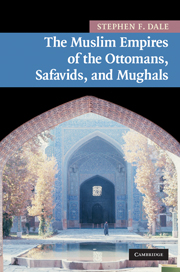Book contents
- Frontmatter
- Contents
- List of illustrations
- List of maps
- Preface
- Languages and transliteration
- Introduction
- 1 India, Iran, and Anatolia from the tenth to the sixteenth century
- 2 The rise of Muslim empires
- 3 The legitimacy of monarchs and the institutions of empires
- 4 The economies around 1600
- 5 Imperial cultures
- 6 Golden ages: profane and sacred empires
- 7 Imperial culture in the golden age
- 8 Quests for a phoenix
- Conclusion
- Glossary
- Dynastic lists
- Bibliography
- Index
4 - The economies around 1600
Published online by Cambridge University Press: 05 October 2014
- Frontmatter
- Contents
- List of illustrations
- List of maps
- Preface
- Languages and transliteration
- Introduction
- 1 India, Iran, and Anatolia from the tenth to the sixteenth century
- 2 The rise of Muslim empires
- 3 The legitimacy of monarchs and the institutions of empires
- 4 The economies around 1600
- 5 Imperial cultures
- 6 Golden ages: profane and sacred empires
- 7 Imperial culture in the golden age
- 8 Quests for a phoenix
- Conclusion
- Glossary
- Dynastic lists
- Bibliography
- Index
Summary
Introduction
Imperial, warrior dynasties generally had three principal economic goals: to acquire sufficient wealth to allow the ruling class to have, in the words of the Mughal historian of Shah Jahan's era, “ a civilized and comfortable life”; to acquire sufficient wealth to fund further conquests and the acquisition of additional resources; and to acquire sufficient wealth to fund grandiose building projects that would glorify the dynasty and legitimize it in the eyes of its subjects and posterity. Apart from plunder, often but not always a lucrative activity, most pre-industrial dynasties had access to three principal sources of wealth: taxes on agriculture, commodity production, and commerce. The economies of the Ottoman, Safavid, and Mughal Empires were structurally identical, and the economic policies of their rulers fundamentally similar. They were also linked with one another through the exchange of commodities and the circulation of merchants.
All three empires were predominantly agrarian states whose rulers derived the bulk of their income from taxes on agriculture, and the size of their populations and economies depended primarily on the agricultural potential of their territories. After agriculture, taxes on commerce constituted a secondary but nonetheless vital source of income, which might come from transit trade, such as the valuable commerce in Indian spices funneled through the Red Sea to Cairo, or from the production and export of manufactured commodities, such as cloth, whether Iranian and Ottoman silk or Indian cotton.
- Type
- Chapter
- Information
- The Muslim Empires of the Ottomans, Safavids, and Mughals , pp. 106 - 134Publisher: Cambridge University PressPrint publication year: 2009



